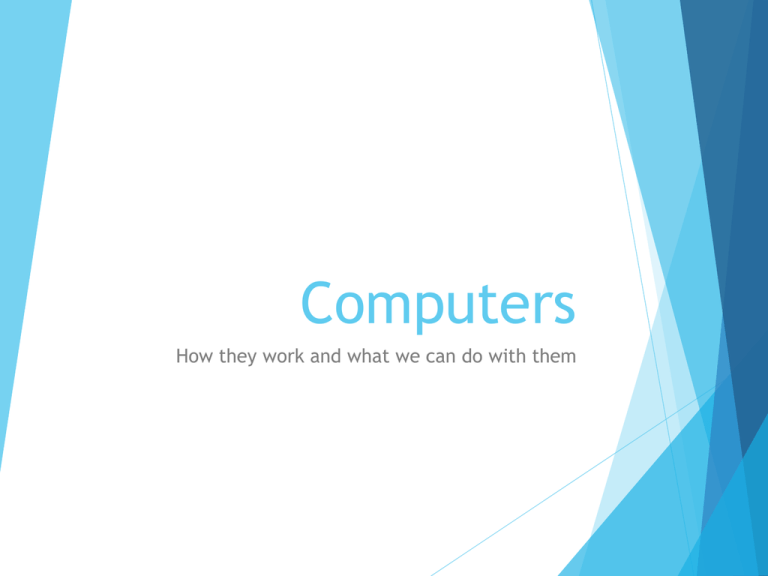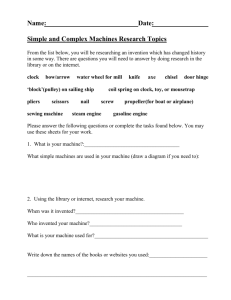Computers
advertisement

Computers How they work and what we can do with them Why Use Computers? What do we use computers for each day? Computer Definition Any electronic machine that stores, processes and retrieves information. One of the most useful and widespread technology tools. Computers have different capabilities Some are slower/faster, smaller/larger Computer Units Unit Number of Bytes Kilobyte (KB) 1,024 Megabyte (MB) 1,024,000 Gigabyte (GB) 1,024,000,000 Terabyte (TB) 1,024,000,000,000 Used to determine file size or storage capacity Types of Computers Microcomputers: extremely small, built into electronics (games, ATMs, cars, phones) Personal Computer (PC): general purpose, single user computer. Mainframe Computer: Large computer used by organizations with many computers that work with large amounts of data. Supercomputer: Fastest and largest used today. Used for research and analyzing huge amounts of data – trillions per second (weather forecasting, climate research, oil exploration, quantum mechanics, etc.) What runs a computer? The operating system tells your computer what to do. It coordinates communication between programs, hardware, and other applications. Examples: Windows 7 – what we use here at school OS X Lion (for MAC) 4 Functions of Computers Input Processing Output Storage Input Everything we tell the computer Data or facts Commands (“open”, “save”) Responses (answers to computer’s questions “Are you sure you want to delete this document?”) Input devices: keyboard, scanner, CD’s, webcam, numeric keypad, etc.) Processing The thinking a computer does (calculations, comparisons, decisions) All computers have CPUs (Central Processing Units) CPU = brains of the computer, small microchip that gets extremely hot which is why the computers have fans inside Output Data that is processed into useful form, now called information (printed papers, information displayed on screen, power points, charts, videos, etc.) Storage Ways computers keep information so it’s available for future use On the hard drive RAM (Random Access Memory) The more RAM a computer has, the more storage space it has You can also store information on external sources like a flash drive (jump drive, thumb drive) or CD-ROM. We can also save on the network J drive. How your computer thinks Computer Parts Computer Parts CPU Computer Parts Hardware vs. Software Hardware is the physical components of the computer (processor, memory, monitor, etc.) Software tells a computer what to do 2 Types: Operating System (Windows 7) Application Program (Word, Power Point, games) Computer Virus A software program that attaches itself to other programs Alter or delete files Consume computer memory NEVER go on the internet without having updated antivirus software installed on your computer. Computer Virus Internet A worldwide network of millions of private, public, academic, business, and government networks Began in late 1960s by the Pentagon WWW = World Wide Web How the Internet works Social Networking Obsessed with Facebook 1.49 billion monthly active Facebook users (2015) 968 million daily users (2015) 83% of those users live outside the U.S. (2015) Social networking is the most rapidly growing area of the internet Twitter is Gaining 316 million monthly active users (2015) 100 million active daily users (2015) 40% of users only follow others, don’t tweet The Future? We are moving towards cloud computing Computers may become nothing more than an internet portal More online sharing, collaboration, and creating Evolution of Computers 3000 B.C. Abacus is invented in Babylonia 600 A.D. Arabic numbers and the concept of zero are invented in India Evolution of Computers 1623 Wilhelm Schickard builds first mechanical calculator 1844 Samuel Morse sends first telegraph message from Washington to Baltimore Evolution of Computers 1895 Guglielmo Marconi transmits first radio signal 1927 First demonstration of television in the United States 1939 prototype of an electronic digital computer is built Evolution of Computers 1947 Bell labs develops the first transistor (fundamental building block of modern electronics) 1953 The IBM 650 becomes the first mass produced computer (filled an entire room) 1960 First computer with keyboard and monitor input (mouse invented in 1964) Evolution of Computers 1973 The “office computer” is developed by Alan Kay 1977 Steve Jobs and Steve Wozniak build Apple II and establish benchmark for personal computers Evolution of Computers 1977 Bill Gates and Paul Allen found Microsoft 1983 Creation of the global internet 1984 CD-ROM developed 2010 76.7% of households have a computer Evolution of Computers 1993 internet carries 1% of information flowing through two-way telecommunication 2000: 51% 2007: 97% 2004 Facebook launched 2008 Laptops out sell desktops

